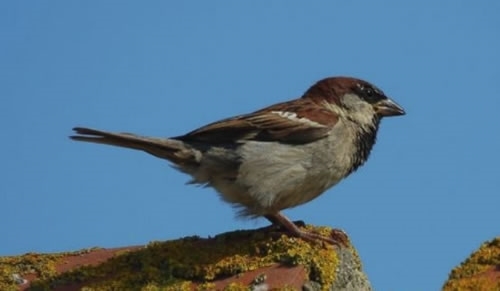Passus domesticus

Habitat
House sparrows tend to reside near villages and farmyard buildings. Their nesting and roosting sites often revolve around people and infrastructure, however they will tend to choose rural locations due to availability of food and less disturbance.
Food
House sparrows have a varied diet. They will feed on a wide range of seeds, as well as aphids and small caterpillars. They will also feed on berries, nuts and fresh buds. They choose farm buildings, due to the instant supply of grain found on farm, they prefer corn, oats and wheat and will forage on the ground.
Nesting
House sparrows are capable of rearing three broods in one breeding season. The will choose areas of closely packed shrub, ivy-covered buildings, thatched roofs and under the eaves of buildings, favouring small holes and crevices. House sparrows will often roost closely together and nests can be as little as 20-30 cm apart. They will also use nest boxes. Their main breeding season is from April to August and most birds will lay two to three clutches. Their young rely heavily on invertebrates such as aphids, caterpillars, beetles and grasshoppers until they fledge after 15 days.
Song/Call
‘Chelp-chrup’- They make a variety of simple chirping and chattering sounds all year round.
Beneficial Management
- Field margins, winter stubbles and wild bird seed crops provide winter seed for adults.
- In spring and summer, field margins, conservation headlands and unimproved grasslands provide seed for adults and insects for chicks.
- Consider erecting nesting boxes in trees near to buildings or feeding stations.
- Consider supplementary feeding with a range of seeds.
Download and print
Download as PDF to print >
Get the Latest News & Advice
Join over 100,000 subscribers and stay updated on our latest advice, research, news and offers.
*You may change your mind any time. For more information, see our Privacy Policy.